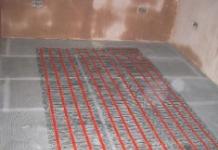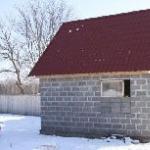EFFICIENT PIPE HEATING
The company "New Systems and Technologies" sells heating cables that allow heating pipes, roofs and gutters. The product catalog contains a large selection of accessories for the heating cable, including pipe mounts. We inexpensively offer products from the world's leading manufacturers. We have all the necessary certificates confirming the high quality and decent performance.
Advantages of cable pipe heating system:
- low prices for both cable products and installation services;
- quick installation and ease of use;
- low power consumption;
- optimally suited for a variety of objects;
- long service life, rarely needs repair.
Heating pipelines at the lowest cost
You can apply for the purchase of products through the site. It is necessary to select a cable for heating pipes and accessories for it, add them to the basket, and then fill in the fields of the order form.
Specialists of the company "New Systems and Technologies" provide a full range of services for the installation of pipeline heating systems. We will complete all the necessary work as soon as possible.
Courier delivery of cables for heating pipes and other products ordered from us is carried out within Moscow and the region. Goods can be sent to other regions of the Russian Federation with the participation of transport services. Self-pickup available.
If you want to clarify what the final price of the goods will be with delivery and electrical installation services, contact the specialists of the New Systems and Technologies company. They will make all the necessary calculations.
In winter, during the period of severe frosts, the owners of country houses run the risk of being left without water supply. Ice plugs in the external water supply will not only leave residents without a shower, a workable system for supplying water to sinks and other benefits of civilization, but will also cause damage to pipes.
Agree, the prospect is unattractive. It will be possible to prevent such a development of events if, together with the pipes, a heating cable for the water supply is installed and connected to the mains. All work is quite possible to carry out independently.
We will tell you how the heating element works and describe the main parameters for choosing it. We will also consider in detail the methods of installing a heating cable and illustrate the stages of work with visual photographs.
It is reasonable to object that you can easily do without. It is enough to find out the level of soil freezing in the area, and then, based on the indicators, dig a trench of the required depth. Usually it is 1.5-1.7 m for the middle lane, depending on the type of soil.
Buried at such a depth and insulated pipes do not freeze, since the surrounding soil has a positive temperature (suppose + 2-4 ° C).
However, not all so simple. In wetlands or in areas close to water bodies, a high level of groundwater is not uncommon. This means that during the period of flood or snowmelt, communications will be flooded, which will negatively affect their functional properties.
If you bury the pipes only half a meter, but at the same time connect the electric cable and, then you won’t have to dig deep ditches.
It happens that in severe winters even buried areas freeze through. Living in a house without automatic water supply from a well becomes less comfortable, and sometimes impossible. Need to carry out emergency repairs
Let's not forget about the critical zones that are most exposed to cold - the places where the pipeline enters the house. If the building is built on a pile-screw foundation, then under it there is an open section of the pipeline, which is easiest to insulate with a heating cable.
Conclusion: if there is a technical possibility of laying a heating system for a water supply system, you must definitely use it, at least for the sake of insurance against freezing.
When contacting a specialized company, you may encounter some variety of offers. Let's take a look at the range.
Image gallery
Heating cables are a specific type of cable products that convert electrical energy into thermal energy for the purpose of heating and perform the function of a receiver of electrical energy, and not a transmission line. Heating cables differ significantly from conventional cables and wires, the purpose of which is to transmit electrical energy with the least losses and with a slight voltage drop over the length of the line (usually no more than 5%).
The heating cable is used in the form of heating sections, i.e. segments of a certain length, and at this length there is a complete drop in the applied voltage. Therefore, the heating section should be considered as an ordinary receiver of electrical energy (as one of the types of electrical heating elements).
The length of cable heating sections usually ranges from a few meters to several hundred meters.
The negative effect of dissipating part of the transmitted energy in the form of heat, which is negative for conventional cables, is used as a useful one in heating cables. Moreover, the conversion of electrical energy into heat occurs in the most optimal and economical way. The transformation is complete, silent, without the use of additional substances (fuel, oxidizer).
Heating cables have a fairly developed range and are used in a wide variety of installations and devices. But still, they belong to a kind of cable products and in the special literature there are practically no works on the design, calculation and use of heating cables.
Types of cables according to the heat dissipation scheme
Resistive linear - heating cables, in which heat is released due to the Joule-Lenz effect during the passage of electric current through the heating core. The cable is designed in such a way that a complete drop in the applied voltage takes place in the heating core, but at the same time the cable elements do not overheat above the permissible values.
The length of the heating section is usually from several to hundreds of meters. Cables of this type can have one, two or more parallel heating conductors, having a linear or spiral shape. Arbitrary cutting of the cable along the length is unacceptable.
The thermal power of resistive linear cables during heating slightly decreases, and the magnitude of the change depends on the value of the temperature coefficient of resistance of the material of the heating core. The smallest changes in resistance are observed in high resistance alloys (TKr + 0.0001), the largest in copper (TKr + 0.004)
Resistive zonal heating cables according to the principle of operation do not differ from the previous ones, but radically differ in design. They contain two parallel insulated conductive wires.
The insulation of conductive cores has periodically located "windows" offset relative to each other with a given step (usually about 1 m). A thin, high resistance alloy wire helix is superimposed over these two strands.
In the "windows" the spiral closes on the conductive cores, as a result, the cable is a set of resistances (resistors) connected in parallel to the conductive cores. On each of them there is a complete drop in the applied voltage. The zone cable is convenient in that it can be cut anywhere. The minimum length of the heating section is 1.5 - 2 m.
The maximum length is determined by the cross section of the conductive wires and the linear power. Since the heating element of resistive zone cables is made of high resistance alloys, their power is practically independent of temperature, which is why they are also called constant power cables.

They have a design partially similar to the design of resistive zone cables. They also contain two parallel conductors, but are not insulated. Conductive wires are either enclosed in a polymeric conductive matrix or connected through helical polymeric conductive threads.
The effect of self-regulation is achieved due to the fact that the heat-generating element of the cable, made of a polymeric conductive material, significantly increases its resistance when heated. The value of TKr of the conductive polymer reaches 0.05-0.075, i.e., 12-18 times greater than that of copper.
Inductive heating cables they contain ferromagnetic elements in their design, and conductive insulated cores are superimposed around the ferromagnetic elements in the form of a winding that induces an alternating magnetic flux in the core. The effect of heat release is achieved both due to resistive losses in the winding and due to resistive losses in the core arising from induced currents.
The ratio of those and other losses is determined by the design of the cable. Core losses can account for 80-20% of total cable losses. In the first case, the losses in the winding are small, and it heats up slightly due to its own losses, which makes it possible to obtain a noticeably larger linear power compared to resistive cables.
The method of heating pipelines using the "SKIN effect" can also be considered as one of the options for an inductive cable. In this case, the role of the inductive winding is performed by an insulated core of large cross section, and the role of the inductor is the steel pipe in which this core is located. Heat is released both in the core and in the pipe due to induced eddy currents.
Areas of application for heating cables
Devices that use heating cables can vary greatly in size, operating temperature, and heat output. Therefore, the range of applications for heating cables is very wide.
Heated clothes, blankets, rugs - electric blankets and rugs, heating pads, heated seats, heated clothes and shoes. As a rule, they have low power (10 - 50 W) and an operating temperature that is safe for humans, i.e. not higher than 50 ° C. The same group may include low-power household heaters: baby food warmers, refrigerator defrosters using heating cables.

Space heating systems - in them, heating cables are used as a heat-releasing element, more or less evenly distributed over the area of the room. If necessary, cables can be mounted on walls and ceilings. The best option for installing cables in terms of heat transfer, heat accumulation, safety and security is to install the cable in the thickness of the cement screed laid under the decorative floor covering.
The temperature on the heated surface is usually 22 - 26°C, but can reach 35°C. The specific power of heating systems through the floor varies in the range of 70-150 W / m². Accumulating systems have a power of up to 200 W/m². The total power of the system can have very wide limits: from 100 W to tens and hundreds of kilowatts.
Anti-icing systems for sidewalks, open stairs, ramps . As in the previous case, the cables are laid in the thickness of the concrete base. These systems function only at the time when snow falls or ice forms on the surface of these objects.
The specific power of open surface heating systems varies in the range of 200-350 W/sq.m. The total power of the system ranges from several to tens of hundreds of kilowatts.
This also includes anti-icing systems for sports facilities (football fields, racetracks, hippodromes, tennis courts), dangerous sections of highways (ascents, descents, sharp turns), runways. The specific heating power of these systems can reach 500W/sq.m., and the total power can reach several megawatts.

Roof de-icing systems serve to prevent: blockage of water runoff routes with ice, the formation of icicles and to remove snow and ice from dangerous areas. Heating cables are placed along the water runoff paths, in downpipes, on cornices, water cannons, on valleys and junctions.
The heating cables used in these systems usually have a linear power of 25 or more W per meter. The total power of the system depends on the design and dimensions of the roof of a particular building and ranges from 1-2 to several hundred kilowatts.
The temperature on the surface of anti-icing systems in the absence of snow and ice and at negative ambient temperatures is usually +5 - 7 ° C. In the process of melting snow and ice, the surface temperature only exceeds 0 ° C by a fraction of a degree. At an ambient temperature above +5°C, anti-icing systems are disabled as unnecessary.

Heating systems for pipelines and tanks . Pipeline systems are very long and branched, and heating cables are the best suited for their heating. In practice, as a rule, there are two types of heating systems - preventing freezing and maintaining the temperature on the pipe above normal (above + 20 ° C). The main purpose of both types of systems is to compensate for heat loss from a pipe (or tank) to the environment.
The heating sections are mounted on top of the pipe (reservoir) and all together are closed with thermal insulation. The linear power of pipeline heating systems is usually 10-60 W/m. The total power of the system depends on the length of the pipeline. The specific power of tank heating systems is 10-80 per 1 sq.m. Heated surface, and the total depends on the size of the tank.
The purpose of systems that prevent freezing is to prevent the formation of ice plugs and rupture of pipelines, therefore it is enough to maintain +5 ° C on the pipe. Temperature maintenance systems can vary quite significantly in the required temperature on the pipe (reservoir): +40 is sufficient for transporting oil and many aqueous solutions ° C, and bitumen requires 160-180 ° C.
Process equipment heating systems are distinguished by a wide variety of purposes, required temperatures, specific powers and are developed on the basis of an individual approach.
|
Purpose of the system |
Temperature, °C |
Specific power, W/sq.m. |
Total power, kW |
|
Thermal barriers in industrial refrigerators |
|||
|
Satellite antenna heating |
|||
|
Heating of degreasing baths |
|||
|
Heated lines for the production of concrete products |
|||
|
Heating of press plates |
|||
|
Heating of cylinders and heads of injection molding and extrusion machines |
Single heater 0.5-2 |
Protection of water and sewer pipes in winter often comes to the fore, especially in regions with difficult climatic conditions. Sometimes it is required to install a self-regulating heating cable for water supply, if an error was made when calculating the depth of soil freezing. Depending on the heating system, the wire can pass both along the outer and inner parts of the pipe. The consequences of freezing communication channels can be critical, because frozen water tends to expand, which leads to pipeline breakthroughs with ice hummocks.
Read in the article:
What is the need for heating pipes
Plumbing communications operating at low temperatures need constant heating, because the water in them is not always in motion. During periods of downtime, ice inclusions may form in some sections of the pipeline, and prevent further movement of water. When the freezing area reaches a certain size, a breakthrough will occur. A heating cable for plumbing can prevent this problem at the stage of the appearance of the first ice. Unlike resistive wires for heating pipes, which are under constant voltage and consume a lot of electricity, a self-regulating cable has features that allow it to be saved.

The main distinguishing feature of a self-regulating wire from a resistive one is the supply of amplified voltage only to those sections of the pipeline where the temperature has dropped below the specified values. Although the self-regulating heating cable for plumbing is also constantly energized, it is almost half as much as the supply resistive conductor.
Self-regulating heating cable for plumbing: device and materials used
This device for heating water pipes has a complex, multilayer structure:
- copper conductors(it is possible to use Ni Cr alloy) - voltage is transmitted through them, the wires consist of many thin woven strands;
- conductive matrix- it is made of carbon fiber, through which voltage and heat spread from copper conductors;


Expert opinion
Engineer-designer of ES, EM, EO (power supply, electrical equipment, interior lighting) ASP North-West LLC
Ask a specialist“Carbon, depending on the ambient temperature, is able to change its conductive properties. Therefore, the carbon conductive matrix is the main element of the self-regulating cable. When the temperature of the pipe decreases in a certain area, the fiber cools down, and its ability to conduct current increases. Due to this, the cable is heated only in the right places and at the moment of critical danger.”

Due to the properties of carbon fiber to change conductive characteristics under the influence of temperature changes, maximum economy is achieved.
Important! The use of copper conductors made of rigid wire for self-regulating cables is impractical, because with frequent bending, such a wire quickly becomes unusable.
Heating self-regulating cable for heating pipes: simplicity and savings
Using a self-regulating heating wire for plumbing will eliminate the need for temperature sensors, which often fail. To connect to the network of such a cable, no additional equipment is required.
In the long term, the use of a self-regulating heating cable for plumbing will be more economical than using a resistive heating cable, although its price is higher due to the complex design and materials used in the manufacture.
The only advantage of a resistive conductor is that using it for already frozen pipes will be no less effective. But in practice this is rare, because if the pipe is completely frozen, then most likely it is already damaged.
The main advantages of a self-regulating cable
The main advantages of self-regulating heating wiring for plumbing can be considered using the example of a comparison with resistive:
- Resistant to temperature extremes. Resistive wire often fails when the temperature in one section of the pipe drops below that in the rest of its length. As a result, the resistance of the cable in the weakest point or close to the cold zone of the pipeline increases and it burns out;
- Resistance to power surges. This is another reason for the frequent failure of resistive cables, but self-regulating conductors are better protected from such drops and are able to work longer under high voltage conditions;
- Safe wire crossing. Several layers of insulation, coupled with a metal screen, completely prevent the possible contact of the conductors. Thanks to this quality, self-regulating cables can be used for heating gate valves and other shut-off equipment;
- Convenient temperature control using a thermostat for heating cable;
- Possibility to change the wire length. Resistor conductors have a certain length, which cannot be changed.

Important! Although changing the length of the wire is considered normal practice, but a strong increase in its size is impossible. The maximum length of such a cable can reach 100-150 meters, depending on the cross section of the copper conductor.
Important points when choosing
When buying a heating cable, you need to understand for what purposes it will serve, the choice of wire should be made taking into account:
- the purpose of the pipeline (water supply or sewerage);
- the material from which the pipe is made (plastic, metal);
- pipe diameter and length;
- properties of the thermal insulation used.
Related article:
In our review, we will consider why a cable is needed, what role it will play in winter, the principle of operation, installation features, average prices, useful tips and recommendations from specialists.
Method of calculation
The building rule - SP 40-102-2000, recommends laying water and sewer pipelines at a depth exceeding the level of soil freezing. However, there are objective reasons under the influence of which this cannot be done (the freezing depth in winter is too large or the soil structure does not allow deepening sufficiently). In this case, it is recommended to use a self-regulating heating cable or its resistor equivalent.
To start calculating the required self-regulating cable, you must have data on:
- specific power of the wire (indicated in the marking);
- dimensions of the heated pipe;
- properties of heat-insulating material and its thickness;
- minimum ambient temperature.
The calculation is made according to the formula:
L cab \u003d K zap × L tr × Q beats / P beats, Where
L cab – calculated length of the self-regulating cable;
K zap - safety factor;
L tr - heated length of the pipe section;
Q beats - specific heat loss, depends on the diameter of the pipe, the thickness of the thermal insulation, as well as the temperature difference between the flowing water and the environment;
P beats is the maximum power of the cable.
But for domestic purposes, you can apply a simple method for determining the power of the wire, so for pipes with a diameter of up to 32 mm, 16 W / m is enough. A pipeline with a diameter of up to 110 mm is capable of heating a cable with a power of 24 W / m.
How to connect the heating cable to the network and fix it on the pipe
Installation of a heating cable on a metal pipe with a diameter of up to 50 mm
| Drawing | Actions |
|---|---|
 | Self-regulating heating cable for plumbing is applied to the top of the pipe, along its entire length. |
 | From above it is fixed with aluminum self-adhesive tape. It is important to achieve the tightest fit of the wire to the surface of the pipe. |
 | When the entire wire is glued, the fixation should be strengthened with plastic ties, every 20 cm. |
 | A heat-insulating material is put on top of the pipeline. It is needed to save the generated heat. |
 | The seam along the edges of the thermal insulation must be sealed with aluminum tape. |
 | If the pipe is fastened with clamps, then the wire must be laid at the junction, between its rubber gaskets. This will avoid damage, even if the clamp is tightly fixed. |
 | In the case when it is required to provide heating for a tap or valve, the wire, even for a small pipe diameter, must be wrapped around the specified node and tightly fixed with ties. |
Fixing a self-regulating cable to a plastic pipe with a diameter of up to 20 mm
| Drawing | Actions |
|---|---|
 | The pipe should be pasted over with aluminum tape in advance. This is necessary for better heat distribution from the wire. |
 | Lay the wire along the pipe and run aluminum tape over it. Cold water is always displaced by warm water towards the upper zone of the pipe, which is why the conductor is laid on top. |
 | Secure with zip ties. This is important, as the aluminum tape does not hold the cable as securely as it should and can be accidentally torn off by physical contact. |
 | Further, the thermal insulation is fastened according to the same rule as above. |
Pipes with a diameter of more than 50 mm must be wrapped with wire in such a way as to ensure heating of their entire area.
Heating cable for plumbing inside the pipe: installation
| Drawing | Actions |
|---|---|
 | This type of heating takes place for pipes of large diameter, and is often used for sewage. It is possible to lay a wire inside the pipe if access to its surface is closed (it is buried). |
 | The pipe must be insulated from the outside with thermal insulation material. |
 | All joints must be glued with aluminum tape, for better heat retention. |
 | The heating wire is laid along its entire length, it is inserted and output using a special gland. This seal is designed to contain water pressure. |
Video review: how to mount a self-regulating heating cable inside a water pipe
If the diameter of the pipe requiring heating is less than 50 mm, but more than 32 mm, it is better to opt for a more powerful wire.
When you mount a self-regulating conductor along a pipe and you come across a node that requires more careful winding, it will be easier to leave a supply of cable and go further, fixing it in the remaining section, and return to difficult places later. This point is also important for the possible subsequent replacement of the valve or valve. After removing the insulation and cutting the ties, the wire will be released, and nothing will prevent the removal of the assembly.

For pipes of large diameter, the cable on which is fixed in a screw-like manner, it should be glued with aluminum tape as carefully as possible, this will reduce heat loss.
If you want to heat a sewer pipe, and as a rule they are at least 100 mm in diameter, then it makes no sense to start the heating wire in a helical manner, since there is no large water pressure there and all the liquid moves along the lower part. It is enough to glue the surface of the pipe with aluminum tape to the middle of the diameter from below, and put the cable into two lines along the bottom.

conclusions
Based on the listed possibilities of using a self-regulating heating cable for water supply, we can sum up the following:
- The use of such heating is advisable, both along the entire length of the pipe, and in certain areas subject to excessive cooling;
- It is more cost-effective to use a self-regulating heating cable than its resistive counterpart;
- By heating large components (gate valves, filters, taps) with a self-regulating wire, you can not be afraid of overlaps;
- The elasticity of the cable allows you to mount it, both outside and inside the pipe, without causing kinks;
- The price of a self-heating cable for water supply depends on its power and the manufacturer's company.
- Carbon fiber allows for increased voltages to heat the coldest sections of the pipe.
Video review: how to lay a heating cable on a pipe
It's time to think about their high-quality thermal insulation. With the introduction of heating cables on the market, which immediately became a huge demand, this problem is no longer insoluble. In this article, we will tell how to choose a heating cable for pipes, consider its types, differences and disadvantages. Let's decide when it is advisable to mount the cable over the pipe, and when inward and whether such installation is safe. We will give advice on choosing the power of the heating element and consider trusted manufacturers.
1. What is the heating cable for?
Someone will say that using a heating cable for prevention is expensive and irrational. And it’s much more logical to find out how deep the soil freezes at the lowest temperatures in your area, and simply deepen the trench to the desired amount. So it is, but far away it is not always possible to deepen 1.5-1.7 meters. For example:
- If you are digging trenches for pipe laying yourself to save money, or you just like to personally control everything, then a lot of physical effort will be required. After all, there is a difference - to go deeper by 0.5 meters or by 1.5?
- It is far from always that the soil on the ground is strong and homogeneous in its composition. You can stumble upon hard rocks in the process of work;
- If the area is swampy, then during the rainy season or snowmelt, the groundwater level can rise greatly, which will lead to flooding of communications. Moreover, this process will be regular, will adversely affect the condition of the water supply system and will certainly lead to its destruction;
- In regions where the temperature drops sharply in winter, even a significant deepening of the trench can not always prevent local freezing;
- The place where pipes enter the house will still remain unprotected;
- And, in the end, what if the water supply has already been finally installed and buried, and the problem has been discovered recently? It is much easier, and in this case cheaper, to install the heating cable inside the pipes than to dig everything out, dismantle, deepen and reassemble.
It follows that sometimes the use of a heating cable is an unavoidable necessity. 
Generally application area includes several main areas:
- For private needs - heating water pipes and sewers, preventing freezing of the roof. In the latter case, the cable is laid in places where icicles and ice cover form. Thanks to this, there is no need to regularly clean the roof. The main element is also a heating cable;
- For commercial - heating pipes or fire extinguishing systems;
- For industrial - when high-risk work is carried out, or there is a need to heat various liquids in large tanks. For example, petroleum products or other chemical compounds.
2. What parameters influence the choice?
Before you purchase the right amount of cable, you need to clearly determine what type fit exactly for your needs. All varieties of this product varies according to five major featured:

3. Resistive heating cable
This type of conductor may consist of one or two steel conductors, which are covered with a layer of insulation, shielding protection and an outer protective sheath. Some cables have two layers of insulation. Solid conductors have some characteristic features:
- They need power at both ends of the cable;
- They create a very strong electromagnetic field, which is harmful to the human body;
Two-core heaters include one heating and one conductive core, which eliminates the need to bring the power supply to the two ends. This greatly simplifies the installation process. 
To general benefits resistive cable include:
- high power;
- Sufficient flexibility;
- Affordable cost;
- Long service life under proper operating conditions and proper installation.
Flaws quite significant:
- Strict length limit. Resistive conductors are produced immediately in a fixed length. It is strictly forbidden to shorten them yourself. Such actions will lead to an increase in resistance due to a decrease in length, which in turn will lead to overheating and failure;
- With excessive accumulation of dirt and debris in the place where the cable is laid or in the presence of places where the cable crosses with itself, overheating and failure are inevitable;
- Since the cable cannot be cut, it becomes impossible to carry out local repairs even if a small area is damaged. The cable will be completely replaced;
- Heat transfer remains constant along the entire length of the heater. Sometimes this leads to overheating of the cable in certain sections or its rapid heating;
- The use of a thermostat is mandatory. This is necessary in order to be able to constantly monitor the temperature and prevent overheating of the conductor. This nuance makes a resistive cable not very suitable for use in places where access is limited.
An improved version of the resistive cable is zonal resistive cable. Its key difference is that it is divided into small zones. This allows you to independently adjust the length of the cable and carry out local repairs or replacements. Its cost is slightly higher. During installation, temperature sensors should also be used, and during operation, ensure that debris does not accumulate around the cable. 
4. Self-regulating cable
More convenient in terms of operation is such a type of heating cable as self-regulating. It has a more complex design and is not single-core. Self-regulating conductor includes into yourself:

To really buy quality cable be sure to pay attention to the labeling. If there are Latin letters CT, CF or CR, this indicates the presence of a copper screen and external insulation. 
In the absence of such marking, it can be argued that you have a semi-finished product of a self-regulating cable. Like any product, the conductor has, like advantages, as well as shortcomings. First about the pros:
- First of all, it is the reliability of the design. Of course, now we are talking about a complete product with a screen and insulation;
- Resistance to voltage drops;
- Even with a high conductor power, the power consumption will be relatively small, which makes the operation economical;
- In addition, savings are achieved due to the monitoring of temperature changes by the system and independent increase or decrease in the heating temperature. That is, without the need, the conductor will not work at maximum power;
- With overlapping installation there is no risk of overheating and failure;
- The self-adjusting conductor is practically maintenance-free;
- The cable is sold as a cut, so you are not limited in length. Accordingly, it can be shortened independently if necessary;
- Due to the flat shape of the cable, it is possible to create the tightest fit of the conductor to the heated surface, which significantly reduces heat loss;
- When the matrix is heated to a temperature of 85°, the system temporarily stops further heating, which protects not only the cable from overheating, but also the pipe surface from melting;
- There is no need to use a thermostat;
- Long service life - 30-40 years.
TO shortcomings can be attributed:

As you can see, self-regulating conductors have radical differences from resistive ones, which have recently practically ceased to be used for heating water pipes.
5. Mounting methods
As practice shows, it is permissible to mount the heating cable not only on top of the pipe, but also inside.
outdoor installation
Any type of conductor is suitable for this type of installation. Advantage this way is:

Depending on the diameter of the heated pipe and the characteristics of the local climate, the cable is recommended install in several ways:

Before mounting over pipes, prepare their surface. Metal pipes are needed. Plastic can be wrapped with foil tape, which will ensure their uniform heating along the entire length.
Internal installation
It is advisable to choose this method with a sufficient diameter of the pipes (section more than 40 mm) so as not to reduce their throughput or when the pipeline is already filled with a layer or bitumen, and there is simply no way to implement an external winding. Single core resistive conductors are not suitable for indoor installation. When choosing a self-regulating cable, be sure to pay attention to the outer insulation material, which should not emit harmful substances and be resistant to alkalis. Also, the cable must have an appropriate protection class - at least IP68.

The installation itself is carried out by inserting the cable into the pipe to the desired length. The end that will be connected to the network is output through a tee, which is wound at the output. In order for the system to be airtight, a special sleeve should be used, the elements of which should be put on the cable in the order shown in the figure.

It is worth noting that internal way mounting has several limitations:


7. Is subsequent insulation of the heated pipeline necessary?
Another topical issue when organizing a pipe heating system is whether subsequent thermal insulation of the heated pipeline is needed? If you do not want to heat the air and operate the cable at maximum power, then insulation is definitely necessary. Insulation layer thickness is selected depending on where the pipes are located and what minimum temperatures are typical for your region. On average, for the insulation of pipes that are located in the ground, a heater with a thickness of 20-30 mm is used. If the pipeline is above ground - at least 50 mm. Very important , which will not lose its properties even after several years.
- Not recommended for use as an insulating material. They are not intended for use in conditions of high humidity, and when wet, they instantly lose their properties. In addition, if wet cotton wool freezes, then when the temperature rises, it crumbles and turns into dust;
- Also, materials that can compress under the influence of gravity are not always suitable. This applies to foam rubber or, which lose their properties when compressed. It is permissible to use such materials if the pipeline passes in a specially equipped sewer, where nothing simply can put pressure on it;

- If pipes are laid in the ground, rigid pipe-in-pipe insulation must be used. When another rigid pipe of a larger diameter is put on top of the heated pipes and the heating cable. For additional effect or in case of operation in harsh conditions, you can wrap the pipes with the same foamed polyethylene, and then put on the outer pipe;

- It is permissible to use, which is fragments of pipes of different lengths and diameters. It has high thermal insulation properties, is not afraid of moisture and is able to withstand some loads, depending on the density. Such a heater is often called a "shell".
8. Cable selection depending on the heat loss of the pipe and its length
In order to choose the right type of heating cable and its power, you need consider the following parameters:
- The purpose of the heated pipe is water or sewer;
- pipe material;
- Its diameter and length;
- Cable laying method - external or internal;
- Material and thickness of thermal insulation;
- The minimum temperature in your area.
Knowing the above parameters, it is possible to calculate the heat loss of the pipe per 1 linear meter and more accurately select the required power and length of the heating cable. Heat loss must be taken into account during the calculation without fail. After all, the power of the cable should be enough to compensate for them, otherwise the heating system simply will not perform its functions. The main factors that need take into account when calculating heat losses include:
- Place of installation of the pipe;
- Minimum ambient temperature;
- Pipe diameter;
- The length of the pipe to be heated;
- The thickness of the thermal insulation and the coefficient of its thermal conductivity;
If you are at a loss in choosing the thickness of thermal insulation, refer to the table, which shows the recommended values. 
The larger the pipe diameter and the thinner the heat-insulating layer, the more heat we need. If you find it difficult to determine the minimum temperature, just ask the appropriate request on the Internet. You can also do to determine the thermal conductivity of a particular thermal insulation material. Be sure to take into account the presence of additional fittings, hangers, supports and other elements on the pipe that will affect the length of the heater. After all, various valves, taps, etc. should also be braided with a cable.
For convenience of calculations, you can use the table, which shows the values of heat loss depending on the diameter of the pipe and the thickness of the thermal insulation at a thermal conductivity coefficient of 0.05 W / m ° C.
9. Manufacturer's choice
In order for the heating cable to serve you for more than one or two years and meet the declared parameters, you need to purchase products trusted brands. Only in this case, the cost of its purchase will be justified. Trusted by the following manufacturers:



















